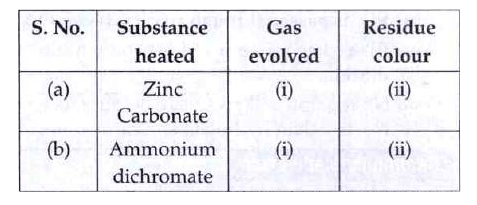How is mole related to the volume of a gaseous substance ?
To understand how the mole is related to the volume of a gaseous substance, we can follow these steps:
1. Understanding the Concept of a Mole:
- A mole is a unit in chemistry that represents a specific number of particles, usually atoms or molecules. One mole is defined as 6.022×1023 particles, known as Avogadro's number.
2. Standard Temperature and Pressure (STP):
- STP is a standard set of conditions for measuring gas volumes. It is defined as a temperature of 273 Kelvin (0 degrees Celsius) and a pressure of 1 atmosphere.
3. Volume of a Gas at STP:
- At STP, one mole of any ideal gas occupies a volume of 22.4 liters. This is a crucial relationship that connects the amount of substance (in moles) to the volume it occupies.
4. Calculating Moles from Volume:
- If you know the volume of a gas at STP, you can calculate the number of moles using the formula:
Number of moles=Volume of gas (liters)22.4 L/mol
- For example, if the volume of the gas is 44.8 liters, you can calculate the moles as follows:
Number of moles=44.8 L22.4 L/mol=2 moles
5. Calculating Volume from Moles:
- Conversely, if you know the number of moles, you can find the volume using the formula:
Volume of gas (liters)=Number of moles×22.4 L/mol
Conclusion:
The relationship between moles and the volume of a gaseous substance is defined by the volume occupied by one mole of gas at STP, which is 22.4 liters. This allows for conversions between the number of moles and the volume of gas.
---
- A mole is a unit in chemistry that represents a specific number of particles, usually atoms or molecules. One mole is defined as 6.022×1023 particles, known as Avogadro's number.
- STP is a standard set of conditions for measuring gas volumes. It is defined as a temperature of 273 Kelvin (0 degrees Celsius) and a pressure of 1 atmosphere.
- At STP, one mole of any ideal gas occupies a volume of 22.4 liters. This is a crucial relationship that connects the amount of substance (in moles) to the volume it occupies.
- If you know the volume of a gas at STP, you can calculate the number of moles using the formula:
Number of moles=Volume of gas (liters)22.4 L/mol
- For example, if the volume of the gas is 44.8 liters, you can calculate the moles as follows:
Number of moles=44.8 L22.4 L/mol=2 moles
- Conversely, if you know the number of moles, you can find the volume using the formula:
Volume of gas (liters)=Number of moles×22.4 L/mol
The relationship between moles and the volume of a gaseous substance is defined by the volume occupied by one mole of gas at STP, which is 22.4 liters. This allows for conversions between the number of moles and the volume of gas.
Topper's Solved these Questions
- SOME BASIC CONCEPTS OF CHEMISTRY BOOK - ICSECHAPTER - SOME BASIC CONCEPTS OF CHEMISTRY EXERCISE - ESSAY LONG ANSWER TYPE QUESTIONS
15 Videos
- SOME BASIC CONCEPTS OF CHEMISTRY BOOK - ICSECHAPTER - SOME BASIC CONCEPTS OF CHEMISTRY EXERCISE - OBJECTIVE (MULTIPLE CHOICE) TYPE QUESTIONS (CHOOSE THE CORRECT OPTION IN THE FOLLOWING QUESTIONS)
58 Videos
- SOME BASIC CONCEPTS OF CHEMISTRY BOOK - ICSECHAPTER - SOME BASIC CONCEPTS OF CHEMISTRY EXERCISE - VERY SHORT ANSWER TYPE QUESTIONS
34 Videos
- SELF ASSESSMENT PAPER 2BOOK - ICSECHAPTER - SELF ASSESSMENT PAPER 2EXERCISE - Questions
62 Videos
- SOME P-BLOCK ELEMENTS BOOK - ICSECHAPTER - SOME P-BLOCK ELEMENTS EXERCISE - NCERT TEXTBOOK EXERCISES (With Hints and Solutions)
63 Videos
Similar Questions
How is the upthrust related to the volume of the body submerged in a liquid?
View SolutionConsider the following statements :
(I)An increase in pressure (caused by decrease in volume) at equilibrium results in increase in molar concentration of each gasous substances involved.
(II)An increase in pressure (caused by decrease in volume) at equilibrium results in increase in no. of moles of each gaseous substance involved.
(III)For the reaction A(s)⇔B(g)+C(g) at constant temperature, total pressure at equilibrium (of B(g) & C(g)) is not affected by changing the volume of container.
(IV)H2O(l)⇔H2O(g) on temperature increase K of this reaction is increased.
Tick the correct statement(s)
View Solution
Knowledge Check
The relations between various variables of gaseous substances are given along with their formulae . which one is wrong?
ADensity and molar mass : M=dRTPBUniversal gas constant , P , V , T : R=PVnTCVolume and pressure : V2=P2V1P1DVolume and temperature : V2=V1T2T1
Complete the following table which relates to action of heat on substances :

View SolutionComplete the following table which relates to action of heat on substances :

View SolutionThe gas law which relates the volume of a gas to moles of the gas is:
View SolutionWhat is the relation between the activity of a gaseous component and its partial pressure ?
View SolutionHeat required to raise the temperature of 1 mole of a substance by 1∘ C is called
View SolutionBiogas and producer gas are made up of more than one gaseous substances. Which of the following is correct?
View SolutionTreatment of ethyl amine and methyl magensium halide produces a gaseous substance X. X is
View Solution
